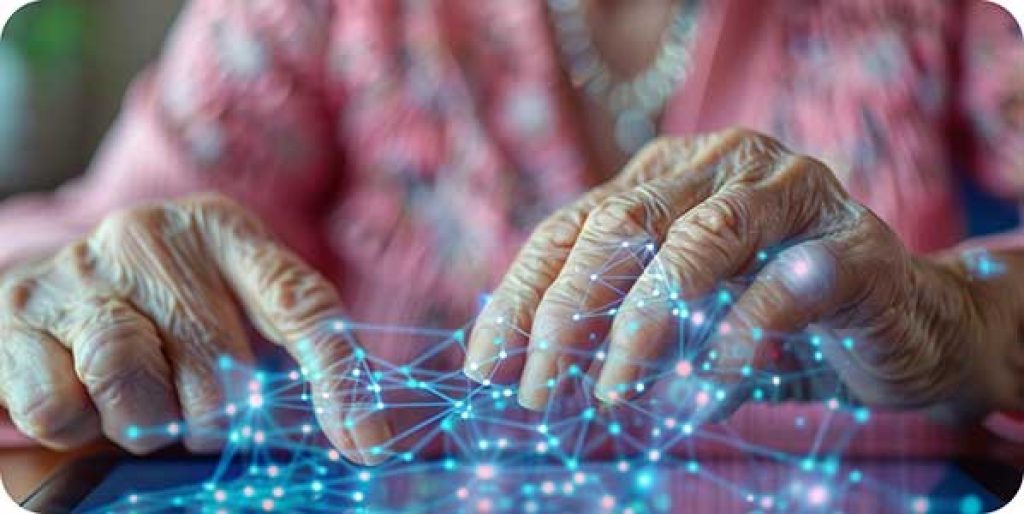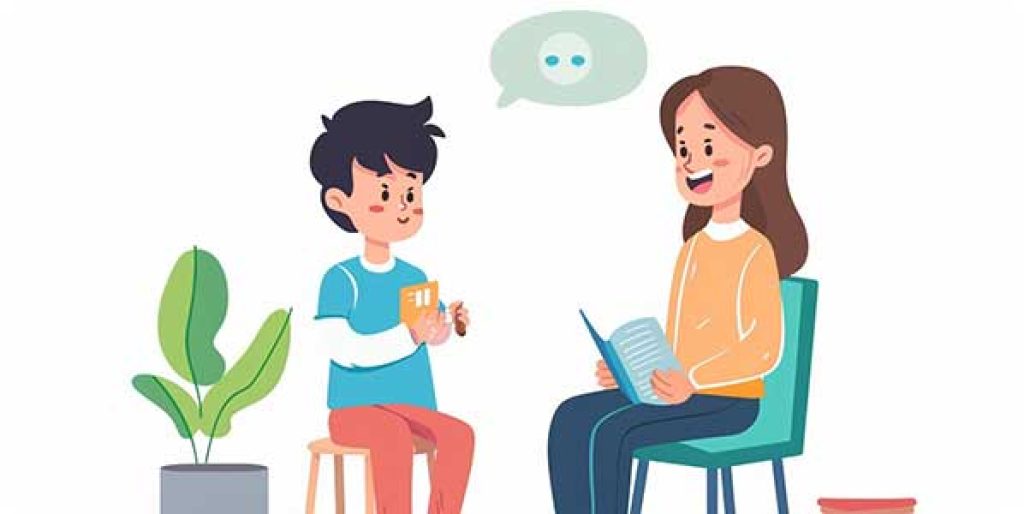Nonverbal Communication Technology & Devices: AAC For Accessibility
Getting The Message Through With AAC Technology
Human communication involves many complex interactions between spoken words and nonverbal cues. We may not even consciously intend to include these cues. A shrug, a raised eyebrow, a sigh: these nonverbal signals add layers of meaning to complement our conversations, expressing intentions, emotions, and responses. A wink can change a stern command into a shared joke, while a grimace may reveal discomfort even when words claim otherwise. Nonverbal communication is a natural part of how humans exchange meaning without words, a way to understand each other, build trust and rapport, and negotiate social interactions.
Throughout history, people have relied on nonverbal communication to overcome language and cultural barriers. Cave paintings, smoke signals, and sophisticated sign languages are all traditional forms of nonverbal communication. While these signs and signals may have only been understood within certain groups at one time, nonverbal communication today leverages technology and connectivity, making it not only more universal, but more available to all. Technology is an increasingly important component in expanding nonverbal communication options, especially for people of all ages with speech disabilities, selective mutism, and other communication challenges. In the last five years alone, we’ve seen a surge in the development and adoption of assistive technology (AT) devices specifically designed to meet the needs of nonverbal communicators.

What Is AAC Technology?
Hand and body gestures, facial expressions, and simple drawings have always been used to communicate, and they still are. With the advent of technology, we’ve simply learned to incorporate these ways of expressing ourselves into tools and devices. From assistive technology for nonverbal students to picture exchange systems for nonverbal people of any age, communication devices can be used by adults and children, giving a voice to those who would otherwise remain unheard.
AAC means Augmentative & Alternative Communication. It refers to many of the ways that thoughts and intentions can be shared without using speech. Alternative methods or devices for non-verbal communication may be used to exchange ideas with a person who cannot verbally speak, or whose speech and words are difficult to understand. The word augmentative means “to add to”, and here it means an additional tool or method of communication that’s used together with spoken words. Augmentative AAC can include writing or drawing, showing photographs or icons, or the use of AAC devices and applications. All these additions to a conversation may clarify what the speaker means to convey. Together, this group of tools, applications, devices and methodologies are categorized as AAC.

Common Technologies For Nonverbal Communication
There are a wealth of options available to assist in nonverbal communication. Some of the most popular and commonly used tools and trends include:
- Assistive Communication Devices (ACDs)
These electronic tools use pictures, symbols, or text-to-speech to allow users to communicate. Such devices, including tablets and specialized keyboards, are often customizable, and can help individuals express spoken words or sentences through the selection of symbols or text. Many newer AAC devices, such as those offered by the Tobii Dynavox company, use eye gaze technology for selection, making them ideal for individuals with limited motor skills. - Motion Sensing Technology
Commonly used in a more basic form for ordinary mobile gaming, advanced motion sensing technology tracks and captures gestures and translates them into digital commands or messages, allowing users to interact with devices through body movements. - Visual and Tactile Communication Systems
These systems use pictures, symbols, objects, or textures to facilitate communication. Examples include Picture Exchange Communication Systems (PECS) and other symbol-based communication boards.
- PECS
The Picture Exchange Communication System (PECS) is a method where nonverbal individuals can exchange picture cards for desired items or actions. In cases where the speech issues are related to developmental delays, PECS may help a child gradually progress towards sentence building and conversation. - Proloquo2Go & Others
Proloquo2Go is a downloadable AAC app that empowers non-verbal individuals to communicate by selecting symbols that the app then vocalizes. This highly customizable and very popular app allows users to choose their preferred icons, voices, and devices for maximum ease of use. Comparable or similar AAC apps include TouchChat HD, Sonoflex, Speech Assistant AAC, Avaz AAC and LAMP Words For Life. - Tactile Overlays
Tactile overlays are physical boards with raised symbols or textures, specifically designed for individuals who also have visual impairments or limited motor skills in addition to being nonverbal or limited in speech abilities. One such product is the TactileTalk Toolkit, which includes transparent sheets with tangible symbols and textures corresponding to pre-programmed pages in the GoTalk Now AAC app. Users can feel the symbol for reference and then tap the corresponding area on the screen for voice output. - Tactile-Only AAC Systems
This subcategory includes object communication boards, manual communication boards, and communication boards with joysticks or switches. Object communication boards hold real objects or miniature replicas that represent specific messages or needs. The user picks up the object to communicate. Manual communication boards have raised symbols or textures representing messages. The user touches the symbol to indicate their choice. Communication boards with joysticks or switches allow users with limited motor skills to navigate and select options using a joystick or switch for voice output.
- PECS
- Web Accessibility Features
Updated web standards and browser features, such as improved screen readers and voice navigation controls, have been integrated into recent browser and operating system versions to assist users with various disabilities in navigating the internet more effectively.
Many websites also now include features like closed captioning for videos, text transcripts for audio content, and screen reader compatibility. All of these features improve accessibility for people who use nonverbal communication methods. - Wearable Technology
Smartwatches, smart glasses and other wearable devices can be used for nonverbal communication through pre-programmed messages, symbol displays, or voice output. Some wearable devices now incorporate gesture recognition and haptic feedback features, providing silent alerts and enabling gesture-based communication. - Augmented Reality (AR) Glasses
A subcategory of wearable technology and smart glasses, AR glasses can overlay digital information onto the real world. These cutting edge devices can aid communication for nonverbal people as they navigate social interactions, with real-time prompts and visual aids. - Smart Home Devices
Some of these voice-activated devices can be controlled using nonverbal commands including facial recognition, allowing users to adjust lighting and temperature, or operate appliances hands-free. - Sign Language Translation Apps
New apps use machine learning to translate sign language into text or speech in real-time, breaking down communication barriers for the deaf and hard of hearing community. Notable releases in this category were updated significantly in the past few years. - Brain-Computer Interfaces (BCIs)
Emerging BCIs, especially those developed in the last two years, offer groundbreaking ways for individuals with severe motor restrictions or speech impediments to communicate through detected brain signals, translating thoughts into speech or text commands. - AAC Accessibility Through Technological Advances
While this does not perhaps stand alone as its own category, it should be mentioned that advances in software, including AI-driven predictive text and built-in speech-to-text applications, improve the speed and accuracy of nonverbal communication. Many such improvements have been recently incorporated as part of major operating systems updates.

Challenges In AAC Technology & Accessibility
Despite the vast potential of technology, there are still hurdles to overcome in making nonverbal communication tools universally accessible.
Cost
Many AAC devices, especially those with advanced features like eye gaze, can be expensive. Studies have found that cost is a significant barrier for those seeking AAC technology.
Tech Literacy
New tools can be a challenge for those who are nonverbal, caregivers and educators. Some tech requires familiarity with specific software or systems, creating a steeper learning curve.
Compatibility
Newer technologies may not always be compatible with existing hardware, systems or assistive technology tools. This can create frustration and force difficult decisions about upgrading systems.
Trial Limits
Limited trial periods can make informed decision-making difficult for individuals, families and educators. Adequate time is needed to test and evaluate communication tech before a purchase.
For individuals who are nonverbal, limited access to technology can mean isolation and frustration. For parents and caregivers, the financial strain of cost and complexity in choosing, learning and adjusting to new tools can add stress to an already challenging situation. Educators already struggle to provide positive, inclusive learning environments; these hurdles add difficulties to their attempts to incorporate new tools into existing educational landscapes.
Multifaceted Solutions To AAC Tech Adoption Obstacles
Subsidies or financial assistance programs can help alleviate the cost burden. Training programs for users and educators can improve tech literacy, making new tools more accessible. Standards for device compatibility must be established so new technologies can be easily integrated with existing systems. And, developing technologies with multi-language support and diverse cultural contexts will make them available and welcoming to a broader audience.
Inclusive Design & User Testing
Why are inclusive design and user testing so critical to the development of truly accessible assistive technology, for AAC and beyond?
Inclusive design, taking all end users into account, means developing technologies that are usable by as wide a range of people as possible, including people with speech-related and other disabilities. When considering nonverbal communication, inclusive design means creating tools that are flexible and adaptable to individual needs. This could involve offering a variety of input methods (such as eye gaze, touch, or voice activation), customizable interfaces, and compatibility with existing technologies. It’s important to remember that each user is different, has their own needs and abilities, and will need a tool that works for them. Web accessibility widgets can help you with testing various accessibility features and in making your website more accessible.
User testing, especially by people with disabilities, is critical to the development and maintenance of true accessibility, both in assistive and adaptive technologies, and for web content and digital tools and devices. User testing for any AAC device, software or system absolutely requires involvement of individuals with speech-related disabilities as well as other concurrent disabilities and conditions, to help test products and services for real usability and accessibility. They must be not only accessible but also functional and effective for the intended users. Such testing identifies potential issues and barriers that might not be apparent to developers or users without disabilities, leading to improvements that make digital environments more inclusive and accessible to all. You can check if your website is accessible, using this handy website accessibility checker.
Overcoming these challenges requires a collaborative effort from technology developers, policymakers, and educational institutions. By working together, we can create a more inclusive digital world where everyone has the opportunity to communicate, learn, and participate.
Who Needs Non-Verbal Communication Devices?
There are many conditions and impairments that can impact verbal communication, leading to a need for AAC methods and technologies, including:
- Speech Sound Disorders
This category includes conditions like Childhood Apraxia of Speech (CAS) and Dysarthria. These disorders affect a person's ability to physically produce speech sounds that are clearly understandable. - Developmental Disorders
Conditions like Down syndrome can cause delays in a child's development, including language skills. AAC tools can provide an alternative way to communicate while speech development progresses. - Acquired Brain Injuries
Injuries like Traumatic Brain Injury (TBI) or stroke can damage the parts of the brain responsible for speech and language. AAC technology can offer a way to regain communication skills after such injuries. - Autism Spectrum Disorder (ASD)
While some people on the autism spectrum are completely verbal, others may have difficulty with spoken communication. AAC tools can provide a method for expressing thoughts, needs, and ideas. An assistive communication device can be a gamechanger for someone with non-verbal autism. - Aphasia
This language disorder, often caused by stroke, can impair a person's ability to understand or speak language. AAC technology can be a helpful tool for regaining communication abilities. - Post-Traumatic Stress Disorder (PTSD)
In some cases, PTSD can manifest in selective mutism, where a person chooses not to speak in certain situations. AAC technology can offer a way to communicate during these times. - Language Development Delays
Some children, even without diagnosed conditions, follow a slower path for speech development. These late talkers may be nonverbal for a period and then surprise everyone by speaking in full sentences. AAC tools can provide a supportive bridge during this time. - Age-Related Cognitive Decline
Conditions like Alzheimer's disease and dementia can affect a person's ability to find words, speak clearly, or construct sentences. For older adults experiencing speech loss due to cognitive decline, AAC can help:
- Maintain Communication
AAC allows individuals to continue expressing wants, needs, thoughts, and feelings, even if speech becomes difficult. - Reduce Frustration
The inability to speak can be frustrating for everyone involved. AAC provides a means for clear communication, reducing frustration for both the person with dementia and their caregivers. - Improve Independence
With AAC, older adults can maintain a sense of independence, because they are able to use it to communicate and make choices. - Support Cognitive Function
Studies suggest using AAC may help stimulate cognitive function and memory in some individuals with dementia.
- Maintain Communication
It's important to note that AAC intervention for older adults with dementia may look different than for children or younger adults. Speech therapists can work with patients and caregivers to develop a customized communication approach using AAC technology.
In short, people at any age or stage may require the use of an AAC or other assistive speech technology, device or system to aid them in communicating nonverbally. The importance of developing, advancing and improving these tools cannot be overstated.
Breakthroughs in Nonverbal Communication Technology
Tools and technologies are advancing at almost a breakneck rather than a breakthrough pace. In advanced speech recognition, machine learning is revolutionizing speech recognition technology, leading to software that can better understand varied accents, speech impediments, and nonverbal cues like tone of voice. This could dramatically improve the accuracy and ease of use for speech generation devices used by people with speech disabilities. Leveraging AI to improve voice recognition software for people with speech impairments, Google’s Project Euphonia works towards making voice-activated devices more accessible to everyone, regardless of their speech patterns. Brain-Computer Interfaces (BCIs), while still mainly in use in a research setting and most often in a medical or scientific study context, have been successful in aiding individuals with severe speech impediments in composing sentences by directly translating brain signals into speech or text, offering a completely hands-free and thought-controlled communication method.
Advanced eye-tracking technology enables users with severe motor impairments to communicate through AAC (Augmentative and Alternative Communication) devices, selecting options on a screen with eye movements alone, as we’ve already mentioned earlier in this article. But did you know that emerging technologies are being developed to read facial expressions and vocal inflections, with the potential to translate emotions into text or speech? This could add a critical layer of nuance to nonverbal communication and help bridge the gap between verbal and nonverbal expression for individuals with speech challenges. Virtual Reality (VR) Communication Environments are in the early stages of planning. They aim to aim to create immersive environments where nonverbal individuals can communicate through avatars, using gesture and motion tracking. And, adaptive AI-driven AAC may help create more intuitive AAC devices that learn and adapt to the user’s communication style over time, improving speed and ease of use.
As technology advances, the development of non-verbal communication devices and software for children, adults, and people of all ages opens new avenues for individuals facing speech and communication challenges, significantly improving their ability to interact and share with the world around them. Artificial intelligence (AI) and machine learning play a pivotal role in developing more intuitive and adaptive communication aids. By analyzing vast amounts of data on language use, communication patterns, and user preferences, AI can personalize interfaces, predict needs, and continuously improve the accuracy and efficiency of communication technologies.
The future of nonverbal communication technology lies in harnessing these innovations to create tools that not only replicate natural speech but also evolve with the user, breaking down barriers to communication in ways that have never been used before. These developments underline the importance of designing with a wide array of human experiences in mind. Making technology accessible to all strengthens our society, building cooperation and a deeper understanding of each other. Assistive technologies for speech impairments are more than just individual aids; they propel us towards a future where everyone’s voice is heard, helping us reach a more unified and inclusive tomorrow.
FAQs
No, nonverbal communication tools can benefit a wide range of people. This includes individuals with speech disabilities, selective mutism, social anxiety, and those who find traditional verbal communication challenging.
If your child is struggling to express themselves verbally, frustrated with communication, or withdrawing from social interactions, consult a speech-language pathologist (SLP). They can assess your child's needs and recommend appropriate communication strategies and technologies.
Many free or low-cost options are available, such as picture exchange systems (PECs) using homemade visuals or simple apps with preloaded symbols. There are also government assistance programs that may help cover the cost of assistive technology for nonverbal students or even adults.
Patience and willingness to learn are key. Simple strategies like giving extra time to communicate and using visual cues can make a big difference.
As technology evolves, ethical questions arise regarding user privacy and data security. It's important to ensure technology is used ethically and supports individual choice and control.
The American Speech-Language-Hearing Association (ASHA) is a valuable resource. They offer information sheets and articles on a variety of communication disorders and assistive technologies.









